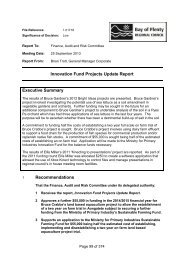Odour Threshold Investigation 2012 - Bay of Plenty Regional Council
Odour Threshold Investigation 2012 - Bay of Plenty Regional Council
Odour Threshold Investigation 2012 - Bay of Plenty Regional Council
You also want an ePaper? Increase the reach of your titles
YUMPU automatically turns print PDFs into web optimized ePapers that Google loves.
Figure 2.3<br />
Relative slope <strong>of</strong> odour intensity for ammonia and hydrogen<br />
sulphide 5 .<br />
As indicated by Stevens’ Law, the perception <strong>of</strong> the intensity <strong>of</strong> odour in relation to<br />
the odour concentration has a logarithmic relationship. The same relationship is<br />
known to occur for other human senses such as hearing and sensitivity to light. This<br />
means that if the concentration <strong>of</strong> an odour increases ten-fold, the perceived<br />
intensity will be approximately double (i.e. a two-fold increase).<br />
2.4 Cumulative effects, desensitisation/adaption and recovery<br />
In most situations a mixture <strong>of</strong> odorants, rather than just a single compound, will<br />
cause odour detection. One single compound may excite more than one type <strong>of</strong><br />
olfactory receptor, while a different odorant is likely to excite a different subset <strong>of</strong> the<br />
350 types <strong>of</strong> human olfactory receptor cells. Studies have been undertaken on the<br />
perceived intensity <strong>of</strong> odour mixtures by mixing two odorants, both above the<br />
detection threshold. The typical finding was that the perceived intensity <strong>of</strong> a mixture<br />
is less than the arithmetic sum (hypo-addition) <strong>of</strong> the individual intensities.<br />
Interactions between mixtures <strong>of</strong> odorous compounds can also occur. An example is<br />
where one compound disguises or masks the presence <strong>of</strong> others. However, as the<br />
odour concentration reduces through dilution, the nature <strong>of</strong> the odour may change<br />
as different compounds dominate the effect; for example, mushroom-composting<br />
odour has been observed to have a distinctly different odour character at source<br />
than when diluted downwind.<br />
Continued exposure to an odour can result in people becoming desensitised so that<br />
they can no longer detect the odour even though the odorous chemical is constantly<br />
present in the air. This is sometimes known as ‘olfactory fatigue’. For example,<br />
people working in an environment with a persistent odour are <strong>of</strong>ten unaware <strong>of</strong> its<br />
presence and may not be aware that the odour is having an impact on the<br />
surrounding community.<br />
6 Environmental Publication <strong>2012</strong>/06–A review <strong>of</strong> odour properties <strong>of</strong> H 2 S <strong>Odour</strong> <strong>Threshold</strong> <strong>Investigation</strong> <strong>2012</strong>
















